Discover Tsuk La Khang Monastery And Its Rich Cultural Heritage In 2025
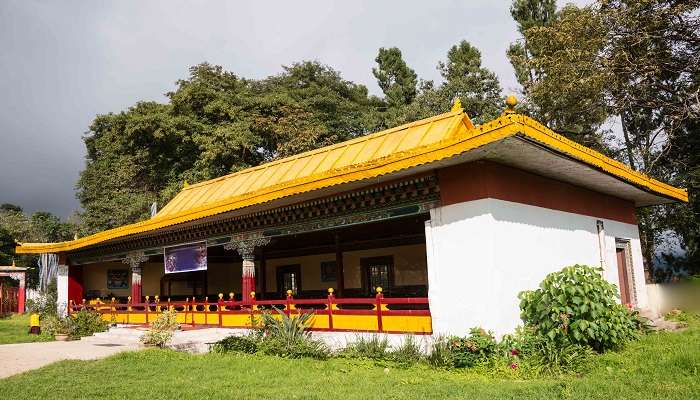
Located 3 kilometres from Gangtok, this beautiful Tsuk La Khang Monastery is situated on the premises of Tsuk La Khang Royal Palace. The atmosphere of the Monastery offers a tranquil environment to the tourists, making it a popular and must-visit attraction on your Gangtok trip. Surrounded by snow-capped mountains, the Tsuk La Khang Monastery in Gangtok allows tourists to immerse themselves in the eternal beauty of Gangtok. If you plan your trip between February and March, you can witness the grand celebrations of festivals like the Tibetan New Year and Cham festival. Visiting the Tsuk La Khang Monastery will make your trip more memorable.
Tsuk La Khang Monastery: History
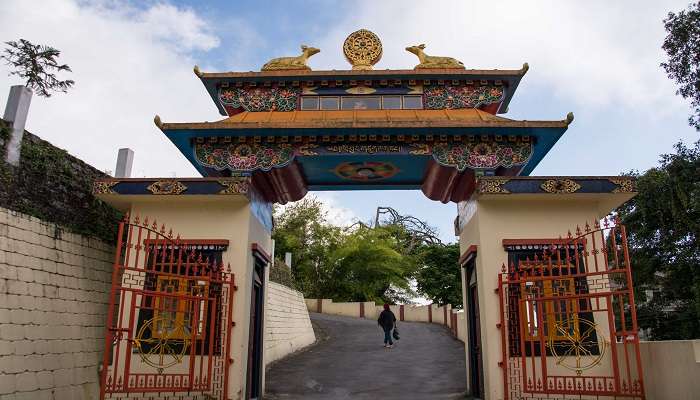
The Tsuk La Khang Monastery in Gangtok has a rich history and is considered a prime place for local Buddhists to worship. The two-storied Buddhist Monastery was built in 1898 during the rule of Thutol Namgyal, the ninth king of Sikkim.
The Tsuk La Khang Monastery was constructed inside the periphery of the Tsuk La Khang Royal Palace, which served as the residence of Sikkim’s Royal family. Earlier, the Monastery hosted significant occasions, including royal weddings and crownings of Sikkim’s Kings and Queens. The Monastery has been a pivotal part of Sikkim’s cultural heritage.
Also Read: Lakes Near Gangtok
Tsuk La Khang Monastery: Architecture
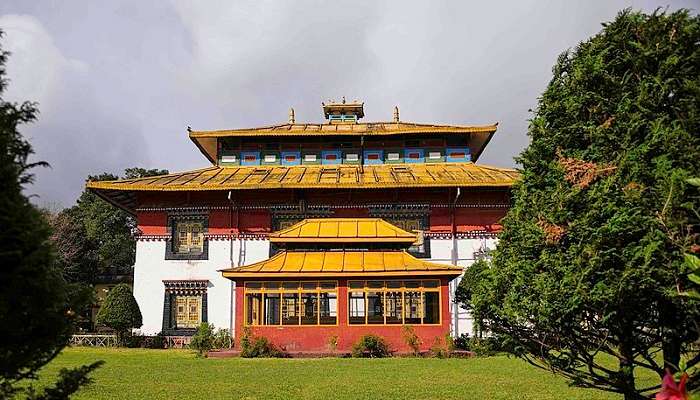
The Tsuk La Khang Royal Chapel was built in traditional Tibetan-style architecture. Tourists will come across a wooden snow-lion statue in every corner of the monastery. Here is a guide that will take you through the entire monastery. As you enter the monastery, you will come across a large hall on the ground floor.
The hall is filled with critical Buddhist books, beautifully painted walls, and numerous pictures of Lord Buddha. You will also come across murals and scriptures. The second floor of the monastery has dedicated altars of tantric deities. There is a giant statue of Lord Buddha in the large prayer hall.
Attractions Near The Tsuk La Khang Monastery
As Tsuk La Khang is located in Gangtok, there are other popular attractions, including monasteries, temples, picturesque viewpoints, markets, and more. Here is a list of places you should add to your must-visit list after exploring the Monastery in Gangtok.
1. Bakthang Waterfall

Located on the 31A National Highway amid the lush green hills, the Bakthang Waterfall should be one of your must-visit places. This picturesque waterfall in Gangtok is worth visiting. The place is just 20 20-kilometre drive from Gangtok and can be covered within a few hours. The waterfall is a part of the Ratey Chu River. The Bakthang Waterfall is surrounded by a canopy of trees, making the waterfall more serene. The waterfall derived its name from two words: “Bak” means forest, and “Thang” means meadows. Near the waterfall, you can find various shops selling Sikkimese clothes, handbags, shawls, woollens, etc.
Distance from the Monastery: 4.9 kilometres
Timings: 24/7
Entry Fee: Free
Related Post: Places To Visit Near Gangtok
2. Do Drul Chorten

Visit the mesmerising white stupa, Do Drul Chorten. The architecture of the Do Drul Chorten is the main highlight that attracts tourists from different regions. The Do Drul Chorten was built in 1945 by the late Trulshi Rinpoche, who was the head of the Nyingma lineage of Buddhism. Before Trulshi Rinpoche established the Do Drul Chorten, it was believed that evil spirits haunted the place. On top of the Do Drul Chorten,108 prayer wheels rotate clockwise while chanting “Om Mani Padme Hum”. Once you enter the Do Drul Chorten, you can see there are Mandala Sets, Kan-your relics, and mantras.
Distance from the Monastery: 5 kilometres
Timings: 8:00 A.M.-6 P.M.
Entry Fee: Free
3. Namgyal Institute of Tibetology

After exploring the Do Drul Chorten, visit the Namgyal Institute of Tibetology, which preserves the cultural heritage of Tibet and is an ideal place for history enthusiasts. The Namgyal Institute of Tibetology researches about the Tibetan language, art, religion, etc. The institute has an extensive collection of religious and cultural artefacts. The Namgyal Institute of Tibetology was built in 1958 on the land gifted by Tashi Namgyal, former King of Sikkim. On the ground floor of the Museum, there is a collection of unique masks, coins, etc. The Shop near the Museum allows tourists to buy souvenirs, including silverware, Sikkimese clothing, and many more.
Distance from the Monastery: 4.7 kilometres
Timings: Monday – Saturday: 10:00 AM – 4:00 PM (Closed on Sundays, Second Saturdays and Government Holidays)
Entry Fee: INR 10
Related Post: Adventure Sports In Gangtok
4. Enchey Monastery
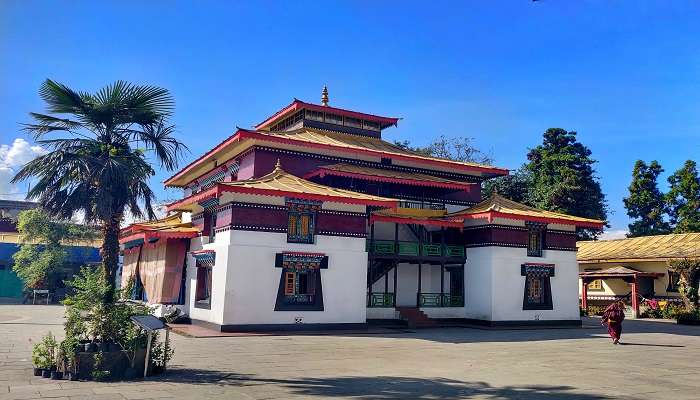
Gangtok is known for its blissful monastery, which is spread throughout the town and is a popular tourist attraction. Enchey Monastery is a famous monastery in Gangtok; you should visit it on your trip to Gangtok. The beautiful Enchey Monastery is 200 years old and surrounded by tall pine trees, blessing the tourists with the captivating view of Mount Kanchenjunga. The Enchey Monastery is home to 90 monks and worships Loki Sharia, Lord Buddha, and Guru Padmasambhava. The monastery has a significant prayer area covered with a metal roof. Tourists will come across images of numerous Gods and Goddesses.
Distance from the Monastery: 2.2 kilometres
Timings: 6:00 A.M. to 4:00 P.M.
Entry Fee: Free
5. Ganesh Tok
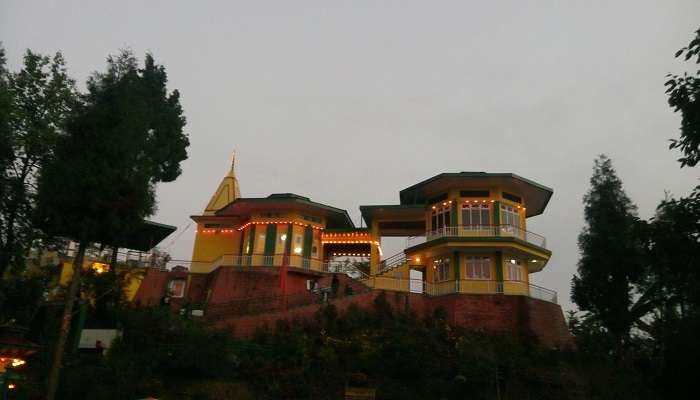
Tourists might come across various religious temples in Gangtok, but the Ganesh Tok stands out. The Ganesh Tok is perched on the quaint hills of Gangtok. The temple is dedicated to Lord Ganesha, and many devotees from different regions of Gangtok visit it during the festival of Ganesh Chaturthi. Perched at a height of 7200 feet, the Ganesh Tok allows visitors to experience the enchanting view of Mount Kanchenjunga. The Ganesh Tok should be on the list of must-visit places of all tourists because the temple will enable tourists to absorb themselves in the pristine atmosphere of the temple along with the mesmerising view of the surrounding places.
Distance from the Monastery: 4.3 kilometres
Timings: 6:00 A.M. to 7:00 P.M.
Entry Fee: Free
You May Also Like To Read: Places To Visit In Gangtok
A visit to Tsuk La Khang Monastery will allow tourists to gain a more profound knowledge of Gangtok’s cultural heritage and the Royal family’s lifestyle. The monastery’s architecture and tranquil atmosphere are captivating. Now, you have complete information about the Monastery or the Tsuk La Khang Palace, including its rich history, architectural brilliance, and places to visit. Book your trip to Gangtok and visit this regal monastery.
For our editorial codes of conduct and copyright disclaimer, please click here.
Cover Image Source: Vinayaraj for wikimedia commons
Frequently Asked Questions About Tsuk La Khang Monastery
What is the best time to visit Tsuk La Khang Monastery?
The best time to visit Tsuk La Khang Monastery is between October and March because tourists can experience pleasant climatic conditions. February is also considered a perfect time to witness the popular Chaam dance.
Where is Tsuk La Khang Monastery located?
The Tsuk La Khang Monastery or the Tsuk La Khang Palace is located 3 kilometres from Gangtok inside the periphery of the Royal Palace.
How to reach the Tsuk La Khang Monastery?
As the Tsuk La Khang is situated near Gangtok there are plenty of travel options for tourists. Buses are available from SNT Bus stations. For more convenience, you can hire a cab to reach the Monastery.
Is Photography allowed inside the Tsuk La Khang Monastery?
The rules for photography may vary, some areas of the Tsuk La Khang Palace allow photography but during any festival or special occasion, photography is prohibited inside Tsuk La Khang Monastery.
What are the timing and entry fees for Tsuk La Khang Monastery?
The Tsuk La Khang Monastery is open for tourists from 7:00 A.M. to 5:00 P.M. Talking about the entry fees, the monastery does not charge any entry fee to the visitors.
Buddhist Monasteries In India Monasteries In Bhutan Monasteries In Thailand

Unveil the hidden treasures of the globe and turn every travel dream into reality. As a Content Writer, I am passionate enough to craft stories from ancient wonders to modern marvels. My words paint the picture-perfect itinerary for unforgettable experiences. Let my words be your trusted guide to immerse in the diverse culture and discover the beauty of the unknown.











